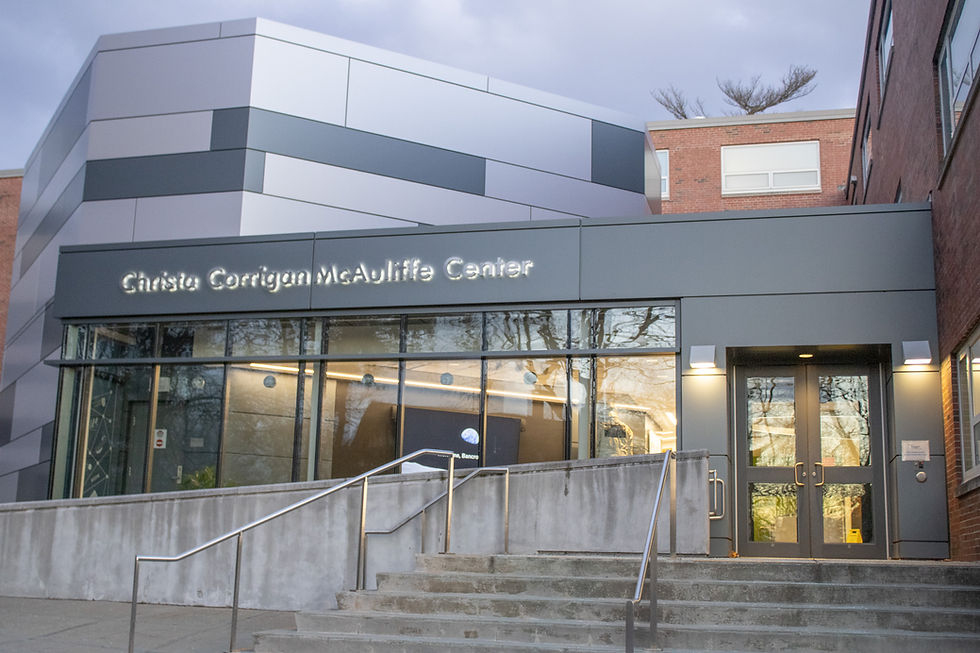One concern found in library air-quality assessment
- Leighah Beausoleil

- Apr 1, 2021
- 7 min read
By Leighah Beausoleil
An indoor environment quality assessment found that one air contaminant related to the printing press in the library was “elevated,” according to Patricia Whitney, assistant vice president of Facilities and Capital Planning.
The study found that while cleaning the printing press, the chemicals used caused elevations in volatile organic compounds (VOCs), according to Whitney in an email sent to faculty and staff on April 1.
She said, “We will proceed immediately to address the study recommendation to modify this one print shop process and eliminate the introduction of these VOCs.”
An indoor environment quality assessment of the Henry Whittemore Library was conducted during the months of January, February, and March due to Massachusetts State College Association (MSCA) members’ concerns about air quality.
A final summary report of the tests that took place was sent in the April 1 email.
An initial summary report of the tests that took place Jan. 19-21 and Feb. 22-23 was sent to faculty and staff earlier this semester by Chemistry Professor Sarah Pilkenton.
Pilkenton, who is on the executive board of the Framingham State chapter of MSCA, said she
“volunteered to be a liaison to the faculty and librarians with respect to the study.”
According to the initial report, an outside vendor, Atlas Company (ATC) Group Services, performed the assessment. The initial tests were for mold, asbestos, radon, hexavalent chromium, respirable crystalline silica, and formaldehyde.
Each testing sample taken, when appropriate, was compared to the guidelines and parameters established by the following: Occupational Safety and Health Administration Permissible Exposure Limits, American Society of Heating Refrigeration and Air Conditioning Engineers Recommended Exposure Limits, American Industrial Hygiene Association Threshold Limit Values, and Massachusetts Department of Environmental Protection Risk Based Indoor Air Sampling Guidelines, according to the initial report.
Multiple samples were taken of each air contaminant and compared to either a field blank or an outdoor air sample, according to the initial report.
Two tests that were still ongoing when this initial report was released were completed March 15, according to the email from Pilkenton. The results of these tests were released with the final report on April 1.
The first ongoing test was for VOCs, which needed additional samples from the Library’s ground level while the printing press was in operation, according to the initial report.
But during the cleaning of the printing press, the initial study “found elevated levels of VOCs in the air at the ground ]oor testing locations,” which was confirmed by the follow up tests to be “related to the chemicals used during the cleaning process.”
The additional tests found VOCs levels were within the recommended parameters while the printing press was not in operation as well as during normal printing operations, according to the final report.
The second ongoing test was for dust and white granular particulate, which was not going to be tested because the Library’s air samples did not indicate a presence of asbestos or respirable crystalline silica, but FSU requested a bulk sample be collected and analyzed, according to the initial report.
Along with the testing of air contaminants, visual observations were also made of “the HVAC system and areas in the building where water damage has been reported.”
According to Whitney’s April 1 summary of the final report, “While no mold or microbials were found, we should continue to work on rectifying the water leaks in the buildings and replace stained ceiling tiles. Minimizing dust collection on surfaces was also recommended.”
After the preliminary report was released, Robert Donohue, a psychology professor and faculty union president, said the MSCA supported union members in their assertion that an assessment was warranted.
In a March 22 interview, Donohue said, “The union certainly has an interest in all aspects of the working conditions of our union members, and a safe environment is, in fact, addressed in the MSCA ... and Board of Higher Education collective bargaining agreement – what people commonly refer to as ‘the contract.’”
He added the administration’s response to the request for the assessment has been “excellent.”
Donohue said when MSCA members contacted President F. Javier Cevallos, he “immediately sought to work to initiate the study,” agreed to let a member of the MSCA executive board be on the committee overseeing it, and has maintained communication throughout the process.
In a March 24 email, Whitney said Facilities plays a “primary role in responding to these types of concerns” due to their responsibility for overall campus maintenance.
Whitney said, “When it comes to more complex air-quality issues, we typically engage the services of a specialist consultant to support our work.”
She added ATC Group Services is a state-approved vendor that has been working with FSU since 2012 in conducting indoor environment quality assessments of multiple campus buildings.
Whitney said there have been past concerns about the Library’s air quality, but no documented or “verified issues that required action.
“The building was constructed in 1974, during a time when energy efficiency was a primary design criteria and architects were focused on natural materials,” she added. “While the building design meets the standards at that time, some people do not like the ‘feel’ of a building that is constructed primarily of concrete without operable windows.”
Whitney said previous assessments were conducted in 2000, 2005, and 2013, with the Library receiving “major” repairs during the summer of 2012 to its air conditioning system.
She added the Facilities Department often conducts testing and inspections, and employees “walk through and conduct visual inspections every morning,” Monday through Friday.
“If they observe anything that needs follow up, we may conduct testing,” she said.
Some student employees who work in person in the Library said they were not aware of the concerns about air quality, but said they do not share them.
Meredith Morin, a circulation desk employee, said, “I didn’t hear about [the assessment] until just now.”
Morin added, “I have not heard any concerns and because of the mask, it’s a little hard to tell what’s the mask and what’s the air quality.”
Bekongcho Aminmentse, an IT help desk employee, said, “Me personally, I haven’t heard any concerns.
“I haven’t had any run-ins with anybody that’s come in and complained about it,” Aminmentse added. “If the air quality has changed, I can’t tell the difference.”
Cormac Walsh, an IT help desk employee, said, “I was here when they were doing air quality tests, and I didn’t know about it until I was on the phone with a professor here, and he started telling me about it. I was like, ‘Oh, that’s why they were here.’”
Walsh said he did not have any concerns about the library’s air quality.
In a March 24 interview, Millie González, interim dean of the Henry Whittemore Library, said concerns about air quality became more prominent when the Library was sorting out how to open back up after the start of the COVID-19 pandemic.
She said the Library had been receiving recommendations from other libraries as well as the CDC on how to open up, including what the air quality should be and how to optimize the ventilation system.
González added there had been past concerns about the air quality, but “I would communicate my staff’s concerns to Facilities, and they always did a really great job.”
Regarding the results of the assessment, she said,“We have staff who have asthma – they have other underlying conditions – and so just seeing that report was very, very refreshing, and really put the staff at ease.”
She added, “I’m just really happy that the extra assessment was done. You know, the library wasn’t a part of it, so my hope is that next time we would be part of it, too, considering we work there, but I’m glad that it’s done.”
This initial report was only shared with faculty and staff, but in an email, Cevallos said the results of the assessment will be made available to everyone once the rest of the report is completed.
González said she would do her part in making student workers aware of the results of the assessment as well as having their individual supervisors do the same.
Following these interviews, new developments took place in the library with the discovery of asbestos in the flooring of WL221.
In a March 31 email, Whitney said, “The carpet in WL221 was in very poor condition, so Facilities had scheduled it to be replaced. During our normal testing work during planning, we discovered that asbestos-containing floor tiles and adhesive still existed under that carpet.
“It is not unusual to find asbestos-containing floor tiles or adhesive under carpeting as it was common practice for tiles, if in good condition, to be covered with other materials,” she added. “DEP [Department of Environmental Protection] specifies that ‘if asbestos is in good condition and it does not pose a health hazard, no laws or regulations require that it be removed.’”
Whitney said it is common for old buildings to contain materials with asbestos, but it only poses a hazard if it is damaged and “friable,” which would make it possible to be ingested or inhaled, adding “floor tiles are non-friable.”
She said because of this, the asbestos would not be picked up in the assessment that was focused on air contaminants.
Whitney added the work done in WL221 was completed by a licensed contractor and is regulated by the DEP. A plastic enclosure was placed as part of the “approved process that ensures any friable asbestos is contained and managed in accordance with the regulations.
“To safely remove asbestos, the workers wear protective equipment and the room is under negative pressure where the air is drawn into the space, and then exhausted directly to the outside,” she said. “As the workers are completing their tasks, they clean off in the small plastic area before coming back into the rest of the building.
“After the work is complete, a certified industrial hygienist conducts air clearance samples,” Whitney said. “This was done on Saturday and the air samples show that no asbestos is left in the air in 221 or in any space outside of 221.”
She said this type of work is usually completed during the summer break, but because of COVID-19, there are fewer people working in the library, allowing for them to complete the projects.
In a March 30 email, Donohue said, “Before the sudden initiation of the asbestos remediation, I had been very happy with the administration’s response.”
He added he is now “quite frustrated” with the administration.
“Workers are concerned that the library may be negatively impacting their health,” he said. “Suddenly, with no warning or explanation, a major environmental intervention is being engaged in.
“This caused many people in the library to be concerned that the intervention was a response to information in the not yet released report,” Donohue said. “People are concerned that being in the library now is particularly dangerous. The administration knew the anxiety of the workers in the library.”
He added, “I wish the administration had anticipated that doing the asbestos work now and without proper communication would cause a great deal of harm.”
In an April 1 email, González said Facilities informed her in advance of the needed work, and she was able to inform her staff.
“There was no need to close the library, so the work was done safely with staff and patrons present on other floors,” she added.
She said she has no concerns, and has “confidence” in the work Facilities has done.





